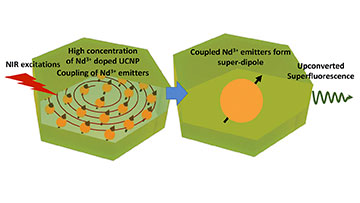Researchers in the United States have shown how upconversion nanoparticles doped with neodymium ions can produce superfluorescent light with very short bursts and at room temperature. [Image: S.F. Lim, NC State University] [Enlarge image]
The fleeting, intense bursts of light generated via superfluorescence could be ideal for a number of applications at the nanoscale, from biosensing to optical computing. However, finding a material that yields suitably short bursts at manageable temperatures has so far proved a challenge.
Now scientists in the United States reckon they may have found just the right material system: upconversion nanoparticles that are doped with neodymium ions. The researchers showed that these nanoparticles, both individually and in groups, yield extremely short bursts of light at lower wavelengths and therefore higher energies than those of the illuminating light—and they do so at room temperature rather than in cryogenic conditions (Nat. Photon., doi: 10.1038/s41566-022-01060-5).
Quest for superfluorescent materials
Superfluorescence occurs when randomly oriented dipoles are exposed to external radiation and align to form a single macroscopic entity. When this entity drops back down to its ground state, it emits a pulse of light that is both brief and intense—the pulse duration is roughly inversely proportional to the number of aligned dipoles and the peak intensity scales with the square of that number.
Superfluorescence was first observed in 1973 but since then has only been seen in a fairly limited number of materials. Those materials typically require cooling to just a few tens of Kelvin to avoid the dipoles being knocked out of kilter, limiting possible applications. Reliable, rapid bursts at room temperature, in contrast, could potentially find a range of uses, such as for the transistors inside high-speed optical computers.
Lanthanide-doped upconversion nanoparticles show promise for applications such as imaging and sensing, given that they emit in the visible region of the electromagnetic spectrum when excited by radiation at longer, near-infrared wavelengths, exhibiting an anti-Stokes shift. However, these materials produce quite lengthy bursts—typically lasting for hundreds of microseconds—which limits their appeal when speed is of the essence.
10,000 times shorter
In the latest work, Shuang Fang Lim and colleagues at North Carolina State University got together with Gang Han and co-workers at the University of Massachusetts to fabricate and test upconversion nanoparticles containing Nd3+. In contrast to other types of nanomaterial used to generate superfluorescence—such as perovskite nanocrystals or semiconductor quantum dots, which emit at the nanoparticle scale—the new system instead yields the sought-after bursts at the scale of an ion by coupling individual ions within a nanoparticle. This coherence at very close quarters enables upconverted radiation at room temperature.
By exposing the nanoparticles to 800-nm light, the researchers were able to generate bursts in the visible region that lasted just 46 ns—some 10,000 times shorter than the lifetime of more conventional upconverted nanoparticles made from ytterbium. They did so using both assemblies of around a dozen nanoparticles and single nanoparticles, and they add that their material required no specific treatment or operating conditions—which, they argue, makes it “versatile and less constrained for broader application scenarios.”
With their demonstration in the bag, Lim, Han and colleagues believe that it should be possible to develop even faster upconversion superfluorescent materials by controlling the concentration of neodymium dopants and the nanocrystal structure. Specific applications that stand to benefit, they suggest, include ultrafast biosensing, high-speed optical transistors and secure communications. But before such materials can form the basis of practical devices, the researchers say they need to better control dipole synchronization at high temperatures.

